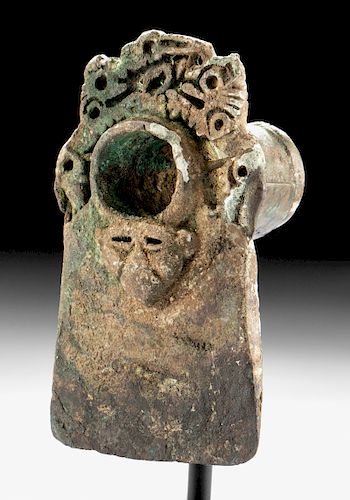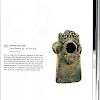Published 9th C. BCE Mongolian Bronze Axe Head w/ Lions
Lot 83
About Seller
Artemis Gallery
686 S Taylor Ave, Ste 106
Louisville, CO 80027
United States
Selling antiquities, ancient and ethnographic art online since 1993, Artemis Gallery specializes in Classical Antiquities (Egyptian, Greek, Roman, Near Eastern), Asian, Pre-Columbian, African / Tribal / Oceanographic art. Our extensive inventory includes pottery, stone, metal, wood, glass and textil...Read more
Categories
Estimate:
$8,000 - $12,000
Absentee vs Live bid
Two ways to bid:
- Leave a max absentee bid and the platform will bid on your behalf up to your maximum bid during the live auction.
- Bid live during the auction and your bids will be submitted real-time to the auctioneer.
Bid Increments
| Price | Bid Increment |
|---|---|
| $0 | $25 |
| $300 | $50 |
| $1,000 | $100 |
| $2,000 | $250 |
| $5,000 | $500 |
| $10,000 | $1,000 |
| $20,000 | $2,500 |
| $50,000 | $5,000 |
| $100,000 | $10,000 |
| $200,000 | $20,000 |
About Auction
By Artemis Gallery
Feb 13, 2020
Set Reminder
2020-02-13 10:00:00
2020-02-13 10:00:00
America/New_York
Bidsquare
Bidsquare : Exceptional Antiquities, Asian, Ethnographic
https://www.bidsquare.com/auctions/artemis-gallery/exceptional-antiquities-asian-ethnographic-4848
An important one-day auction featuring museum-worthy examples of Egyptian, Greek, Roman, Etruscan, Near Eastern, Far East / Asian, Pre-Columbian, African / Tribal, Oceanic, Native American, Spanish Colonial, Russian, Fossils, Ancient Jewelry, Fine Art, so much more! Artemis Gallery info@artemisgallery.com
An important one-day auction featuring museum-worthy examples of Egyptian, Greek, Roman, Etruscan, Near Eastern, Far East / Asian, Pre-Columbian, African / Tribal, Oceanic, Native American, Spanish Colonial, Russian, Fossils, Ancient Jewelry, Fine Art, so much more! Artemis Gallery info@artemisgallery.com
- Lot Description
Ancient Eurasia, north/east Asia, inner Mongolia, ca. 9th to 7th century BCE. A beautiful cast-bronze axe head formed via the lost wax (cire perdue) method with delicate openwork detailing along the upper periphery. The weapon is comprised of a cylindrical socketing shaft with two vertical perforations for attachment and a broad trapezoidal axe blade with a sharpened edge and a thick shoulder. Above the shaft is an intriguing openwork scene depicting two powerful lions pouncing upon a long-eared rabbit shown in the middle, and below the shaft is an abstract anthropomorphic face maskette bearing almond-shaped eyes and a broad nose. The ornate nature as well as the horizontal blade head of this axe suggest it was created for use in ancient ceremonial or ritual practices, and mottled layers of green and brown patina have formed across the composition. Size: 1.875" W x 3.125" H (4.8 cm x 8.3 cm); 4" H (10.2 cm) on included custom stand.
Published in: Pang, Tina. "Treasures of the Eurasian Steppes: Animal Art from 800 B.C. to 200 A.D." Ariadne Galleries, New York, 1998, no. 80.
Provenance: private Connecticut, USA collection; ex-private Canadian collection, acquired in the 1970s; published in: Pang, Tina. "Treasures of the Eurasian Steppes: Animal Art from 800 B.C. to 200 A.D." Ariadne Galleries, New York, 1998, no. 80
All items legal to buy/sell under U.S. Statute covering cultural patrimony Code 2600, CHAPTER 14, and are guaranteed to be as described or your money back.
A Certificate of Authenticity will accompany all winning bids.
We ship worldwide and handle all shipping in-house for your convenience.
#152767Repairs to both corners of blade and areas of openwork zoomorphic elements, with resurfacing and very light adhesive residue along break lines. Minor abrasions and nicks to blade, shaft, and openwork animals, with light encrustations, and softening to some finer details. Nice earthen deposits and wonderful patina throughout.Condition
- Shipping Info
-
All shipping is handled in-house for your convenience. Your invoice from Artemis Gallery will include shipping calculation instructions. If in doubt, please inquire BEFORE bidding for estimated shipping costs for individual items.
-
- Buyer's Premium



 EUR
EUR CAD
CAD AUD
AUD GBP
GBP MXN
MXN HKD
HKD CNY
CNY MYR
MYR SEK
SEK SGD
SGD CHF
CHF THB
THB















